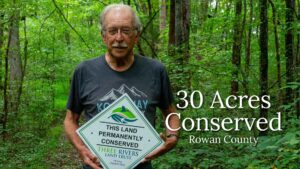
By: Crystal Cockman
Last Saturday, we had our regular trail workday on the Uwharrie Trail, and a great group of folks came out to help improve the

trail. This included some raking, some limb trimming, and some places where they had to move dirt and rocks to level out the trail in spots. During one of those instances, a trail volunteer moved a rock and uncovered a pretty rare and beautiful critter – a scarlet snake (Cemophora coccinea).
Scarlet snakes are a nonvenemous snake often confused with a scarlet king snake or the venomous coral snake. Scarlet snakes typically lack the bright yellow of the scarlet king, and the bands on the scarlet snake do not extend all the way across the snakes body. You may be familiar with the expression “red on black, friend of jack; red on yellow, kill a fellow,” which helps distinguish the nonvenomous snakes from the coral snake.
Scarlet snakes are fairly small, growing only up to about two feet in length. They are mainly nocturnal, which is why our trail group found this guy hiding under a rock in the daytime. They are found only in the United States, mainly in the southeast, and there are three subspecies, the Northern, Florida and Texas scarlet snake.

Scarlet snakes prefer forested habitats with sandy and well-drained soil, and are good at burrowing. They do hibernate over the winter, and their diet consists mainly of small reptiles and eggs. One interesting fact about scarlet snakes is that they have enlarged teeth to open eggs too large for them to swallow.
Though not a threatened or endangered species, scarlet snakes are uncommon in this area, and generally uncommon in Piedmont areas throughout their range, so it was an exciting find. They are found more prolifically in the Sandhills and coastal plain, and are not really found in the mountains region. They are one of our state’s watch list species, meaning that they are not rare in the state but they are regionally uncommon and known to be declining, most likely from habitat loss. They are found in both hardwood and pine forests; and flatwoods, prairies, sandhills, and bottomland forests are some specific habitat types in which they can be found.

They are pretty uncommon and unique, so consider yourself fortunate if you ever chance upon one. We’d certainly be interested to hear about an encounter also, and if you are willing to share your story, you can email me at crystal@landtrustcnc.org. Hopefully the snake we found during our workday wasn’t too traumatized by the experience, and maybe we will see him again on a future hike or backpacking trip on the trail.
